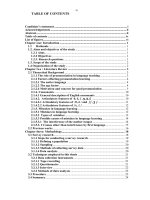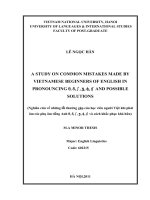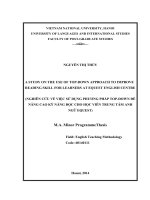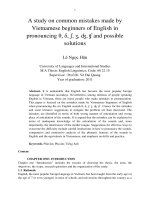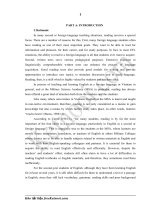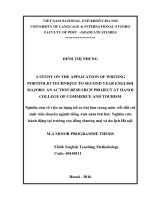A study on common pronunciation mistakes and recommended solution to improve receptionists’ english speaking skills at sea view hotel
Bạn đang xem bản rút gọn của tài liệu. Xem và tải ngay bản đầy đủ của tài liệu tại đây (2.26 MB, 60 trang )
BỘ GIÁO DỤC VÀ ĐÀO TẠO
TRƯỜNG ĐẠI HỌC DÂN LẬP HẢI PHÒNG
-------------------------------
ISO 9001:2015
KHÓA LUẬN TỐT NGHIỆP
NGÀNH: NGÔN NGỮ ANH
Sinh viên
: Nguyễn Thị Tâm
Giảng viên hướng dẫn
: Ths.Phạm Thị Thúy
HẢI PHÒNG - 2019
BỘ GIÁO DỤC VÀ ĐÀO TẠO
TRƯỜNG ĐẠI HỌC DÂN LẬP HẢI PHÒNG
-----------------------------------
A STUDY ON COMMON PRONUNCIATION MISTAKES AND
RECOMMENDED SOLUTION TO IMPROVE
RECEPTIONISTS’ ENGLISH SPEAKING SKILLS AT SEA
VIEW HOTEL.
KHÓA LUẬN TỐT NGHIỆP ĐẠI HỌC HỆ CHÍNH QUY
NGÀNH: NGÔN NGỮ ANH
Sinh viên
: Nguyễn Thị Tâm
Giảng viên hướng dẫn
: ThS.Phạm Thị Thúy
HẢI PHÒNG - 2019
BỘ GIÁO DỤC VÀ ĐÀO TẠO
TRƯỜNG ĐẠI HỌC DÂN LẬP HẢI PHÒNG
--------------------------------------
NHIỆM VỤ ĐỀ TÀI TỐT NGHIỆP
Sinh viên: Nguyễn Thị Tâm
Mã SV: 1412751031
Lớp: NA1802
Ngành: Ngôn Ngữ Anh
Tên đề tài: A study on common pronunciation mistakes and
recommended solution to improve receptionists’ English speaking skills at
Sea View Hotel.
NHIỆM VỤ ĐỀ TÀI
1. Nội dung và các yêu cầu cần giải quyết trong nhiệm vụ đề tài tốt nghiệp
( về lý luận, thực tiễn, các số liệu cần tính toán và các bản vẽ).
Nhiệm vụ đề tài là: Nghiên cứu về các lỗi phát âm phổ biến và giải pháp
được đề xuất để cải thiện nhân viên tiếp tân về kỹ năng nói tiếng Anh tại
Sea View Hotel.
2. Các số liệu cần thiết để thiết kế, tính toán.
……………………………………………………………………………
……………………………………………………………………………
……………………………………………………………………………
……………………………………………………………………………
……………………………………………………………………………
……………………………………………………………………………
……………………………………………………………………………
3. Địa điểm thực tập tốt nghiệp:
Sea View Hotel
CÁN BỘ HƯỚNG DẪN ĐỀ TÀI TỐT NGHIỆP
Người hướng dẫn thứ nhất:
Họ và tên: Phạm Thị Thúy
Học hàm, học vị: Thạc sĩ Ngôn Ngữ Anh
Cơ quan công tác: Trường Đại Học Dân Lập Hải Phòng
Nội dung hướng dẫn: A study on common pronunciation mistakes and
recommended solution to improve receptionists’ English speaking skills at
Sea View Hotel
Người hướng dẫn thứ hai:
Họ và tên:.............................................................................................
Học hàm, học vị:...................................................................................
Cơ quan công tác:.................................................................................
Nội dung hướng dẫn:............................................................................
Đề tài tốt nghiệp được giao ngày … tháng ….. năm …..
Yêu cầu phải hoàn thành xong trước ngày …. tháng ….. năm ……
Đã nhận nhiệm vụ ĐTTN
Sinh viên
Đã giao nhiệm vụ ĐTTN
Người hướng dẫn
Nguyễn Thị Tâm
Th.S Phạm Thị Thúy
Hải Phòng, ngày ...... tháng........năm 2019
Hiệu trưởng
GS.TS.NGƯT Trần Hữu Nghị
CỘNG HÒA XÃ HỘI CHỦ NGHĨA VIỆT NAM
Độc lập - Tự do - Hạnh phúc
PHIẾU NHẬN XÉT CỦA GIẢNG VIÊN HƯỚNG DẪN TỐT NGHIỆP
Họ và tên giảng viên:
Phạm Thị Thúy
Đơn vị công tác:
Trường Đại Học Dân Lập Hải Phòng
Họ và tên sinh viên:
Nguyễn Thị Tâm. Chuyên ngành: Ngôn Ngữ Anh
Nội dung hướng dẫn:
A study on common pronunciation mistakes and
recommended solution to improve receptionists’ English
speaking skills at Sea View Hotel
1. Tinh thần thái độ của sinh viên trong quá trình làm đề tài tốt nghiệp
..............................................................................................................................................
...... ..............................................................................................................................................
...... ..............................................................................................................................................
2. Đánh giá chất lượng của đồ án/khóa luận (so với nội dung yêu cầu đã đề ra trong
nhiệm vụ Đ.T. T.N trên các mặt lý luận, thực tiễn, tính toán số liệu…)
...... ..............................................................................................................................................
...... ..............................................................................................................................................
...... ..............................................................................................................................................
...... ..............................................................................................................................................
3. Ý kiến của giảng viên hướng dẫn tốt nghiệp
Được bảo vệ
Không được bảo vệ
Điểm hướng dẫn
Hải Phòng, ngày … tháng … năm ....
Giảng viên hướng dẫn
(Ký và ghi rõ họ tên)
QC20-B18
CỘNG HÒA XÃ HỘI CHỦ NGHĨA VIỆT NAM
Độc lập - Tự do - Hạnh phúc
PHIẾU NHẬN XÉT CỦA GIẢNG VIÊN CHẤM PHẢN BIỆN
Họ và tên giảng viên:
..............................................................................................
Đơn vị công tác:
........................................................................ .....................
Họ và tên sinh viên:
...................................... Chuyên ngành: ..............................
Đề tài tốt nghiệp:
......................................................................... ....................
............................................................................................................................
............................................................................................................................
.........
1. Phần nhận xét của giáo viên chấm phản biện
...... ..........................................................................................................................................
...... ..........................................................................................................................................
...... ..........................................................................................................................................
2. Những mặt còn hạn chế
..........................................................................................................................................
...... ..........................................................................................................................................
...... ..........................................................................................................................................
3. Ý kiến của giảng viênchấm phản biện
Được bảo vệ
Không được bảo vệ
Điểm hướng dẫn
Hải Phòng, ngày … tháng … năm ......
Giảng viên chấm phản biện
(Ký và ghi rõ họ tên)
QC20-B19
TABLE OF CONTENTS
ABSTRACT ...................................................................................................... iv
ACKNOWLEDGEMENTS .............................................................................. v
PART 1: INTRODUCTION ............................................................................. 1
1. Rationale ....................................................................................................... 1
2. Aim of the study ........................................................................................... 2
3. Research ....................................................................................................... 2
4. Scope of the study ........................................................................................ 2
5. Design of the study ....................................................................................... 3
PART 2: DEVELOPMENT .............................................................................. 4
CHAPTER 1: THEORETICAL BACKGROUND ......................................... 4
1.1. Introduction .................................................................................................. 4
1.2. Pronunciation ............................................................................................... 4
1.2.1. Definition .................................................................................................. 4
1.2.2. The importance of pronunciation............................................................... 5
1.3. What is English pronunciation error? ........................................................... 6
1.4. Consonants .................................................................................................... 7
1.4.1. Definition .................................................................................................. 7
1.4.2. Classification and description of consonants ............................................. 8
1.5. English ending sounds .................................................................................10
1.5.1. Definition .................................................................................................10
1.5.2. Ending sound errors ..................................................................................12
CHAPTER 2: THE STUDY ............................................................................14
2.1. Participants and purposes of the survey questionnaire ................................14
2.2. Design of the questionnaire .........................................................................14
2.3. Findings and discussion ...............................................................................15
2.3.1. Data analysis.............................................................................................15
2.3.1.1. Receptionists’ attitudes on English speaking skill in general and
pronunciation in particular .................................................................................15
i
2.3.1.2. Receptionists’ interest in pronunciation and their frequency of making
pronunciation mistakes. ......................................................................................19
2.3.1.3. Receptionists’ ending sound errors ........................................................24
CHAPTER 3: SUGGESTIONS TO DEAL WITH RECEPTIONISTS’
PRONUNCIATION PROBLEMS. .................................................................26
3.1. Suggestions to accurately pronounce 5 common ending sounds /d ʒ/, /θ/, /ʃ/,
/ð/ and / ʒ /..........................................................................................................26
3.2. Suggested solutions to avoid ending sound errors and have good
pronunciation. .....................................................................................................29
3.2.1. Suggested tips ...........................................................................................29
3.2.2. Games and exercises.................................................................................32
3.2.3. Tongue twisters ........................................................................................37
3.2.4. Good books for pronunciation. .................................................................37
3.2.5. English songs ............................................................................................40
PART 3: CONCLUSION ...................................................................................43
THE SURVEY QUESTIONNAIRE FOR RECEPTIONIST .............................44
REFERENCES ...................................................................................................47
ii
LIST OF FIGURES, CHARTS AND TABLES
Chart 1: The most favorite skill of receptionists at Sea View Hotel. ..................16
Chart 2: The percentages of important factors in speaking ...............................17
Chart 3: The importance of pronunciation in English speaking .........................18
Chart 4: Receptionists’ interest in pronunciation ..............................................19
Chart 5: Receptionists’ experience in English pronunciation. ...........................20
Chart 6: Receptionists’ frequency of making pronunciation mistakes................20
Chart 7: Receptionists’ common pronunciation mistakes ..................................22
Chart 8: Receptionists’ reasons for difficulties when pronouncing ending sounds23
Figure 4: Production of the sound /dʒ/ ..............................................................27
Figure 6: Production of sound /θ/. ....................................................................27
Figure 7: Production of sound /ʃ/. ......................................................................28
Figure 8: Production of sound /ð/. .....................................................................28
Figure 9: Production of sound /ʒ/. .....................................................................29
Table 1: Percentage of ending sounds faced by receptionists ............................22
Table 2: Receptionist’ opinion about solutions to deal with pronunciation
mistakes. .............................................................................................................24
iii
ABSTRACT
In the current open economy, tourism activities are becoming more and
more popular and along with that, the domestic tourism industry has been
developing strongly, becoming a spearhead economic sector of the whole
country, one the smokeless economy brings many benefits to the nation's
economy, culture and society. Although it was born quite late compared to many
other economic sectors, Vietnam tourism has made steady steps and achieved
many achievements .One of the most important factor in the working
environment for Sea View Hotel employees is communication skills but many
of them are facing with problems in English speaking not only in daily
communication but also in the process of working with clients. The purpose of
this study is to identify the pronunciation errors in the receptionists'
communication and find appropriate solutions to improve English speaking skill.
25 employees answered a questionnaire to collect information. The research
results show that the lack of English skills leads to a mispronounce and the fear
of communication is the main problem for Sea View employees. These
problems are caused by the occasional use of English in daily communication
leading to feelings of confusion and anxiety. The proposed solution is to rotate
jobs to increase the opportunity to communicate with foreign customers and
English-speaking courses with native speakers. In addition, to provide more
useful recommendations, data obtained from management level requires further
research.
iv
ACKNOWLEDGEMENTS
During the process of conducting my graduation paper, I received many
supports and helps from my teachers and friends. I would like to extend my
sincere thanks to those lending me hand while I spent my internship time in Sea
View Hotel as well as many individuals supporting me in accomplishing the
general report.
First of all. I would like to express my gratitude to my supervisor, Mrs.
Pham Thi Thuy M.A for her guidance and precious comments she gave
throughout my research. I am also grateful to teachers from Foreign Language
Faculty at Haiphong Private University who had useful lectures and valuable
knowledge in this field of the study.
In addition, I would like to express my gratitude towards members of Sea
View Hotel or their kind co-operation. Especially, it is Ms. Tran Thu Huyen
who gives me a chance to have access to necessary information.
Finally, I take this opportunity to express my indebtedness to my friends
who always stand by me and give me their supports to accomplish this study.
Hai Phong, April, 2019
Nguyen Thi Tam
v
PART 1: INTRODUCTION
1. Rationale
In recent years, English has become a very popular language in the world
and in Vietnam as well. People use English for communication, travel, for one
culture and trade exchanges and so many other fields in life. Vietnam is one of
the countries which use English as the second language and as a result, English
has adopted as one of the most important subjects in many Hotels in Vietnam.
Four English skills are essential for every English learner of all ages,
nonetheless, learners seem to focus on reading and writing rather than speaking.
They spend a lot of time on learning grammar for weekly tests and examination
in each semester, meanwhile they are quite afraid of speaking English. In
Hotels, speaking English seems to be less paid attention than the others. They do
not spend much time practicing speaking in class and that is the main reason
why they get difficulties with speaking. Moreover, many receptionists are weak
on grammar, they lack vocabulary and feel so why communicating in English.
In fact, there are many other factors that affect speaking English such as
intonation, grammar, linking, rhythm, and context and so on… and pronunciation
is considered the most important one. During my speaking periods in Sea View
Hotel and speaking test, fact shows that there many receptionists who get trouble
with pronunciation like I do, especially English beginners and making
pronunciation in English speaking becomes a popular problems. After long time of
observing and investigation, ending sounds seems to be the most common
pronunciation mistake of receptionists at Sea View Hotel.
As can be seen, if receptionists want to speak English correctly and
fluently, they need to pay attention to pronunciation. Vietnamese is kind of
language which has single words with no ending sounds while those play an
important role in English pronunciation. That is reason why Vietnamese learners
have difficulties with English pronunciation, particularly ending sounds and that
is also main problems of receptionists at Sea View Hotel.
1
Therefore, in order to study this problem in depth, the author has as
conducted the research entitled: “A study on common pronunciation mistakes
faced by receptionists at Sea View Hotel”. Hopefully, this study will help
receptionists understand deeply about the issues that they have not noticed
before and suggest some solutions to solve the problems and help them improve
their pronunciation.
2. Aim of the study
This study is to help receptionists realize their ending sounds errors. It
also help receptionists’ have awareness of pronunciation problem and give some
suggestions to deal with their ending sound errors. This reception will focus on
two issues. The first one is to find out the most common English ending sound
errors. The second one is about some solutions for their pronunciation problems.
3. Research
These followings are three research questions of this study:
1) What is the most common pronunciation mistake that receptionists at
Sea View Hotel tend to make when speaking English?
2) What are ending sound errors that receptionists’ are likely to face?
3) What are solutions to help receptionists’ avoid pronunciation mistakes
and solve their problems?
4. Scope of the study
There are many mistakes of English pronunciation that receptionists
encounter when speaking. However, this study will not cover all problems in
learner’s pronunciation and there are so many different material resources that
require a lot of time effort while abilities and experiences of the author are
limited. Therefore, this research will focus on the most common pronunciation
mistakes of receptionists at Sea View Hotel that is ending sound. The author will
concentrate on five common ending sound mistakes from survey questionnaire
chosen by 25 receptionists from Sea View Hotel. The author hopes this study
will be a useful material for every receptionists who concern this issue and help
to get rid of their pronunciation mistakes
2
5. Design of the study
This study consists of three parts:
Part 1: Introduction
In this part, rationale, aims, methods, scope and design of the study were
provided to introduce and to become basic for next chapter. Theoretical
backdrop about English pronunciation and ending sound errors will be presented
in second.
Part 2: Development
This part will consist of three chapters:
Chapter 1: Theoretical background provides the definition of English
pronunciation its importance and some opinions of pronunciation errors.
Consonants is also presented in this chapter.
Chapter 2: The study of the most common pronunciation mistake: ending
sound errors. Survey questionnaire will be carry out in order to find out the most
common ending sound errors that receptionists at Sea View Hotel tend to make
when speaking.
Chapter 3: Findings and discussion: Basing on the data collection from
survey questionnaire, the issues will be analyzed in depth in order to provide
realistic information about ending sound mistakes of receptionists. This chapter
also is about some suggestions to avoid receptionists’ pronunciation problems
which are mentioned above and solutions in order to help receptionists have
good pronunciation.
Part 3: Conclusion
The results from the investigation about ending sound problems of
receptionists at Sea View Hotel in part 2 will be concluded in this part
3
PART 2: DEVELOPMENT
CHAPTER 1: THEORETICAL BACKGROUND
1.1. Introduction
The aim of this chapter is to review theoretical background which related
to English ending sound errors. Basic knowledge will be provided in order to
help receptionists consolidate their knowledge and understand the issues deeper
with definition of pronunciation, its importance, pronunciation error and so on.
1.2. Pronunciation
1.2.1. Definition
To every English speaking learners, the first thing they need to learn is
pronunciation. They have to know how to pronounce a word exactly before they
learn the other things, so what is pronunciation? In this part, definition of
pronunciation will be presented to provide more information for all
receptionists.
First of all, pronunciation is “the way a word or a language is spoken, or
the manner in which someone utters a word. If one is said to have “correct
pronunciation", then it refers to both within a particular dialect”, according to
Wikipedia.
In the AMEP Fact sheets that have been funded by the Department of
Immigration and Multicultural and Indigenous Affairs through the AMEP
Special Project Research Program, pronunciation was defined as: “The
production of sounds that we use to make meaning. It includes attention to the
particular sounds of a language (segments), aspects of speech beyond the level
of the individual sound, such as intonation, phrasing, stress, timing, rhythm
(suprasegmentally aspects), how the voice is projected (voice quality) and, in its
broadest definition, attention to gestures and expressions that are closely
related to the way we speak a language. Each of these aspects of pronunciation
is briefly outlined below, and references for further study are suggested.”
4
Wikipedia Dictionaries indicates another definition of pronunciation:
“Pronunciation refers to the ability to use the correct stress, rhythm, and
intonation of a word in a spoken language. A word can be spoken in different
ways by various individuals or groups, depending on many factors, such as: the
area in which they grew up, the area in which they now live, if they have a
speech or voice disorder, their ethnic ground, their social class, or their
education.”
Besides, pronunciation was also put as “the way in which a language is
spoken” (Oxford Advance Learner’s Encyclopedic, 1992:718). The Oxford
Advanced Learner’s Dictionary, 8th end (2008) makes clear pronunciation is “the
way in which a language or a particular word or sound pronounced”.
There are so many different definitions of pronunciation, this one from
Oxford Dictionary seems to be easier to understand: “pronunciation is the way
in which a word is pronounced”.
1.2.2. The importance of pronunciation
As mentioned above, pronunciation is very important in speaking. Many
people ignore pronunciation when speaking English, especially receptionists.
They take further notice of word meanings while pronunciation is considered as
the most important factor in speaking. The others cannot understand if words we
pronounced wrong. Therefore, in order to speak English correctly, pronunciation
should be paid more attention to. Furthermore, right pronunciation can help with
the process of acquiring new vocabulary. Pronouncing words is often a part of
memorizing them in second-language learning, so getting a strong, basic
foundation in correct pronunciation early on will equate to more effective
learning overall.
According to AMP Fact sheets of AMP Research Centre, “ learners with
good pronunciation in English are more likely to be understood even if they
make errors in other areas, whereas learners whose pronunciation is difficult to
understand will not be understood, even if their grammar is perfect” and “Yet
many adult learners find pronunciation one of the most difficult aspects of
5
English to acquire, and need explicit help from the teacher (Morley 1994;
Fraser 2000). Surveys of student needs consistently show that our learners feel
the need for pronunciation work in class (egg willing 1989). Thus some sort of
pronunciation work in class is essential”.
From Higgs Graph of Learner Needs, pronunciation is something that is
very important to beginners. It allows them to feel more comfortable when
speaking. Obliviously, no one can deny the importance of pronunciation. It
considered as one of the most significant factors in English speaking.
Hence, receptionists should take pronunciation into account in order to
have good speaking.
1.3. What is English pronunciation error?
When learning any language, making mistakes in pronunciation is
unavoidable, especially for new English learners. Error can be defined “the
flawed side of learner speech or writing”, which “deviates from some selected
norm of mature language performance” by Dulay, Burt and Krashen
(1982:138).
Richards (1971) acknowledges two different kinds of errors: performance
errors, caused by, such as, fatigue and inattention, and competence errors
resulting from lack of knowledge of the rules of the language. In another
research, Ellis (1997) states that errors reflect gaps in a learner’s knowledge;
they occur because the learner does not know what the correct one is. However,
mistakes reflect occasional lapses in performance they occur because in
particular instance, the learner is unable to perform what she or he knows Ellis
(1997).
In short, every English learner would make pronunciation mistakes at
least several times while learning speaking and each one has their own problem.
However, receptionists should recognize and solve their pronunciation problem
as soon as possible.
6
1.4. Consonants
There are so many mistakes of pronunciation that receptionists often make
when speaking English such as ending sounds, word and sentence stress or
misunderstanding of vowels… but I would like to concentrate on the most
common mistakes of receptionists at Sea View Hotel. That is ending sound.
Before studying about ending sounds, students have to learn about
consonants first. In this chap, receptionists will get some useful information
about definition, classification and description of English consonants.
Figure 1: Consonants and vowels (Reprinted from Sound foundations
1994 by Adrian Underhill with kind permission of Macmillan Education, UK)
1.4.1. Definition
According to the Oxford Advanced Learner’s Encyclopedic (1992:192),
consonants are “speech sounds made by completely or partly stopping the flow
of air breathed out through the mouth”.
7
Consonants is also defined “ A speech sound that's not a vowel; a letter of
the alphabet that represents a speech sound produced by a partial or complete
obstruction of the air stream by a constriction of the speech organs”.
In English phonetics and phonology (Peter Roach, 2000:10), the term
consonant can be defined as: “sounds in which there is obstruction to the flow of
air as it passes the larynx to the lips”. The production of sounds, consonant was
defined: “Consonant sounds are the sounds, in the production of which one
articulator moves towards another or two articulator moves towards another or
two articulators come together obstructing the air stream and the air stream can’t
get out freely.”
1.4.2. Classification and description of consonants
Figure 2: Diagram of the vocal tract showing the places of articulation
According to place of articulation, consonants are classified into 9 types:
Bilabials: are the sounds made with the two lips pressed together
or coming together /b, p, w, m/
8
Labia-dentals: are the sounds which are produced with the lower
lip touching the upper front teeth /f, v/
Dentals: are the sounds which are produced with the tip or blade of the
tongue touching the upper front teeth. / θ, ð/
Alveolar: are the sounds which are produced with the tip or blade of the
tongue touching or approaching the alveolar ridge. /t, d, s, z, n, l/
Retroflex: is the sound which is produced with the tip of the
tongue curling back towards the back of the alveolar ridge. /r/
Palate - alveolar: are the sounds which are produced with the tongue tip
or blade coming close to the area between the back of the alveolar ridge and the
front of the hard palate. /ʃ, ʒ, tʃ, dʒ/
Palatal: is the sound which is produced with the front of the
tongue coming close to the hard palate. /j/
Velars: are the sounds which are produced with the back of the tongue
touching the soft palate. /k, g, ŋ/
Glottal: are the sounds which are produced without the active use of the
tongue and other parts of the mouth. /h/
According to manner of articulation, consonants include 6 types:
Nasals: they are produced with the air- stream being stopped in the oral
cavity but the soft palate is down so that the air can go out through the nose. /m,
n, ŋ/
Plosives: are the sounds which are produced with the air-stream being
stopped in the oral cavity and the soft palate is raised blocking off the
nasal cavity. Then the two articulators come apart quickly and the air escapes
through the oral tract. /p, b, t, d, k, g/
Fricatives:
are
the
sounds
in
the
production
of which
two
articulators come close together but there is still a small opening between
them so the airstream is partially obstructed and an audible friction noise is
produced. /f, v, ʃ, ʒ, θ, ð, s, z, h/
9
Affricates: are the sounds which are produced when a stop is immediately
followed by a fricative. / tʃ , dʒ/
Lateral: is the sound which is made when the air-stream is obstructed at a
point along the center of the oral tract, with incomplete closure between one or
both sides o the tongue and the roof of the mouth. / l /
Approximants: are the sounds in the production of which two articulators
come close together but without the vocal tract being narrowed to such an extent
that a friction noise is produced. /r, w, j/
Figure 3: Classification of English consonants (Cawley, 1996).
1.5. English ending sounds
1.5.1. Definition
To every English learners, the word “ending sound” is pretty popular in
speaking. To understand easily, “ending sounds” are sounds that occur at the end
of the word. It refers to the consonant sounds as the word can end with one or
more consonant sounds (consonant clusters). Ending sounds are called Codas:
“The coda is the final consonant or consonant cluster.” (Barbara and Brian,
1997). According to Rachael-Anne Knight, 2003, University of Surrey–
Roehampton (Understanding English Variation, Week 3). There are 4
10
consonants in a coda. If there are no consonants at the end of the word, it has a
zero coda. A single consonant is called the final consonant. Any consonant
except “h, r, w and j” may be a final coda. Example: Final consonant sounds in
English are listed as below:
/p/ - sheep, stop, cheap
/tʃ/ - teach, watch, much
/t/ - start, smart, seat, meat, wet
/dʒ/- bridge, large, village
/d/ - ride, sad, bread, road
/m/- come, some, warm,
time
/ŋ/ - sing, spring, wrong,
/k/ - pick, speak, peak
wing
/f/ - leaf, belief, roof, half, sniff
/l/ - pool, smile, veil, call
/v/ - leave, arrive, live, love, five
/ʒ/ - message, garage,
massage
/θ/ - earth, health, worth
/g/ - beg, dog, clog, bag
/ð/ - breathe, clothe, with
/ʃ/ - crash, wash, rush
/s/ - stress, goes, rice, bus, six
When there are two or more consonants standing at the end of the word,
the terms “pre-final” and “post-final” consonants are used.
Pre-final includes: /m/, /n/, /ŋ/, /l/, /s/
Post-final includes: /s/, /z/, /t/, /d/, /θ/
Two consonant clusters:
Pre-final: /m/, /n/, /ŋ/, /l/, s followed by a final consonant
Consonant plus post-final: /s/, /z/, /t/, /d/, /θ/
Example: help, bank, books, blind etc.
Three consonant clusters:
Pre-final plus final plus post-final (e.g.: stopped, speaks)
Final plus post-final plus post final: /s/, /z/, /t/, /d/, /θ/ (e.g.: next, thousands)
Four consonant clusters:
11
Most are pre-final plus final plus post-final (e.g. twelfths, prompts)
occasionally there is one final and three post final consonants (e.g. sixths,
texts...).
1.5.2. Ending sound errors
According to Mark (2008), ending sound errors can be defined as “the
inaccurate pronunciation of the final consonant in a word”. The classifications of
ending sounds errors were given out according to Treiman (1989). They are:
Cluster reduction, Cluster Simplification, Epenthesis, Coalescence, Omitting
nasal and liquid sounds and phonetically possible spelling.
Hereunder is introduction about 6 types of ending sounds errors
according to Treiman (1989): Cluster reduction: This is the “deletion of one or
more consonants from a target cluster so that only a single consonant occurs at
syllable margins” (Grunwell, 1987: 217, as cited in Treiman (1989) ).
Cluster reduction: This is the “deletion of one or more consonants from a
target cluster so that only a single consonant occurs at syllable margins”
(Grunwell, 1987: 217, as cited in Treiman (1989)).
Cluster Simplification: The error occurs when one/some elements of a
cluster being is/are produced in a different manner from the target phoneme
(Grunwell (1987), as cited in Treiman(1989))
Epenthesis: This is the insertion of some vowel (normally a schwa)
between cluster elements (Dyson & Paden (1983), as cited in Treiman(1989))
Coalescence: It occurs when the yielded pronunciation contains a new
consonant composed of features from the original consonants. (Dyson & Paden
(1983), as cited in Treiman(1989)).
Omitting nasal and liquid sounds: In consonants cluster consisting of
prefinal+ final consonants with nasals (/n/,/m/) or liquids (/r/,/l/) as the first
element, (/m, n, l, r/ + final consonant), nasals and liquid sounds are often
omitted (Treiman, Zukowski & Richmond, Wetly, (1995 )).
12
Phonetically possible spelling: In representing the first consonant of a
cluster, spellers tend to spell words in an inaccurate but phonetically plausible
ways (Treiman &Bourassa. (2000).).
In her research, ending sound errors were divided into 3 groups:
Reduction is omitting the final consonant or one element of a cluster.
Insertion is inserting a consonant to the ending of word.
Substitution is replacing an English consonant by a phonetically similar
of Vietnamese sound. In current study, the findings of receptionists’ tapes
recorded and observation will be analyzed according to the three types of errors
as mentioned above.
13


